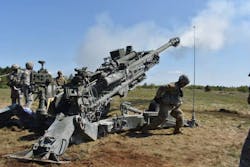Army approaches industry for prototype artillery cannon for future Hypervelocity Gun Weapon System (HGWS)
FORT BELVOIR, Va. – U.S. Army air defense experts are reaching out to industry for companies able to build a prototype Multi-Domain Artillery Cannon (MDAC) able to shoot down enemy manned and unmanned aircraft, missiles, and artillery shells with hypervelocity projectiles.
Officials of the Army Rapid Capabilities and Critical Technologies Office (RCCTO) at Fort Belvoir, Va., issued a request for information on Monday for the Multi-Domain Artillery Cannon (MDAC) project.
The MDAC air defense prototype will be a wheeled self-propelled 155-millimeter artillery system able to shoot the Hypervelocity Projectile (HVP). The HVP and its sister subsystem, the Multi-Function Precision Radar (MFPR), are being developed under separate projects as part of the future Hypervelocity Gun Weapon System (HGWS) program.
Army officials want as many as eight MDAC prototypes to be delivered in fall 2027, for demonstration in 2028, followed by possible field deployment.
The MDAC seeks to slash munition costs and enhance anti-aircraft artillery capability. The system's hypervelocity projectile will communicate with off-board sensors that track the HVP and the incoming threat before shooting the threat down.
The MDAC will interface with an external Army-furnished Command and Control Battle Manager (C2BM) and the Integrated Air and Missile Defense (IAMD) Battle Command System (IBCS).
Related: High-G data recorder helps Air Force munitions testing
The Army wants a company to build and deliver MDAC prototypes using existing fielded and mature technologies. MDAC will be air-, rail-, and sea-transportable per MIL-STD-1366; will be able to move rapidly for survivability; have automated high rates of fire with HVP; and have emote weapon firing; have deep magazine capacity, rapid ammunition resupply, and high operational availability. Companies interested also will demonstrate supportability, safety, and cyber security.
The MDAC project also calls for a new propelling charge that makes the most of muzzle velocity performance. Companies interested should email capability statements no later than 24 July 2024 to the Army's Joshua Flinn at [email protected] and Sydney Horn at [email protected]. Email questions to Flinn and Horn no later than 17 July 2024.
More information is online at https://sam.gov/opp/cb63719cd3b24d4294fe3bc74405bb06/view.
About the Author
John Keller
Editor-in-Chief
John Keller is the Editor-in-Chief, Military & Aerospace Electronics Magazine--provides extensive coverage and analysis of enabling electronics and optoelectronic technologies in military, space and commercial aviation applications. John has been a member of the Military & Aerospace Electronics staff since 1989 and chief editor since 1995.
